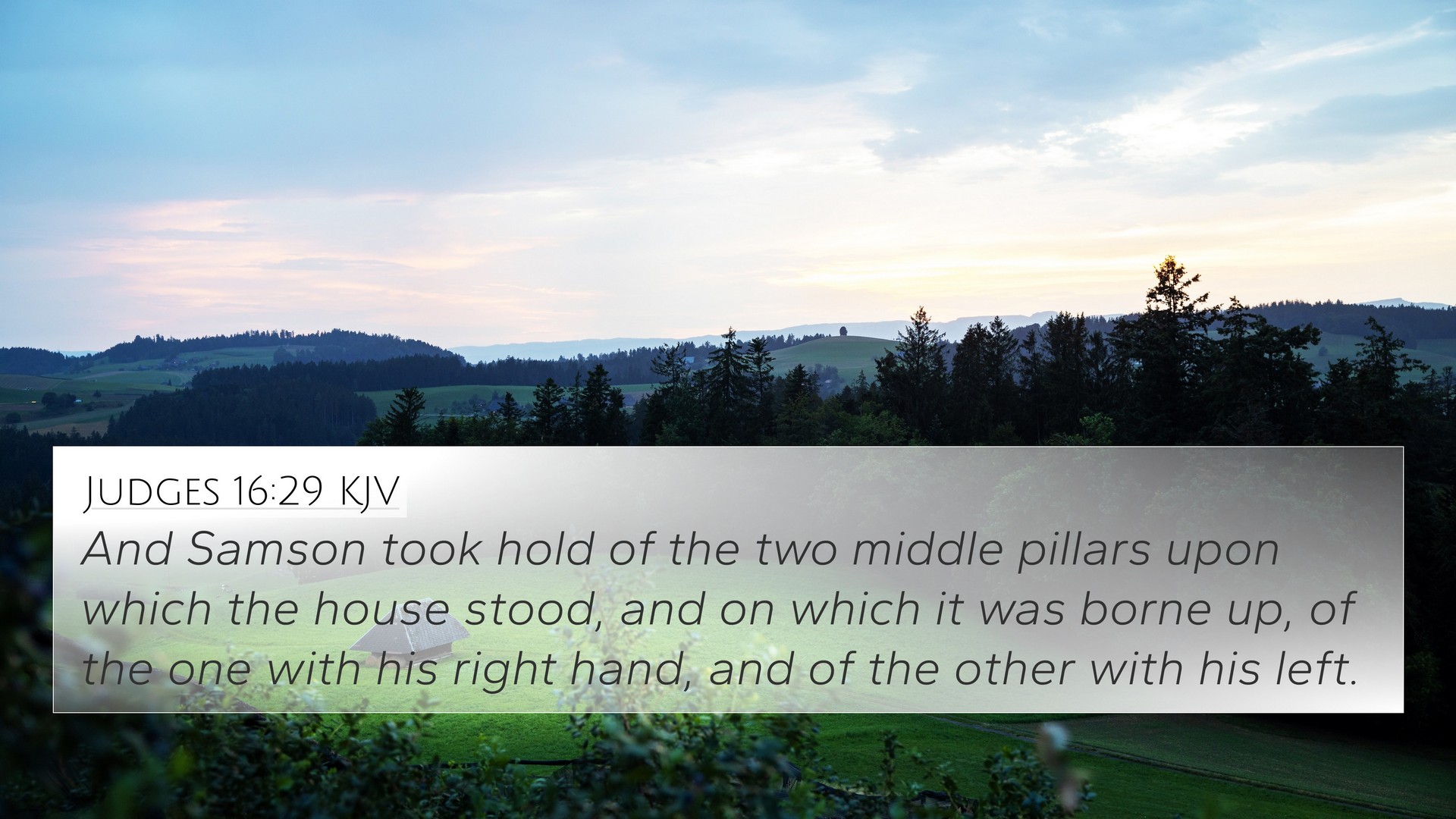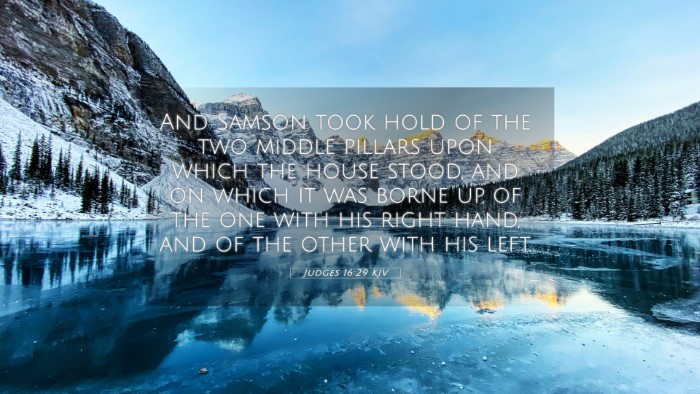Understanding Judges 16:29
Judges 16:29: "And Samson took hold of the two middle pillars upon which the house stood, and on which it was borne up, of the one with his right hand, and of the other with his left."
Summary and Context
In Judges 16:29, we witness the final act of Samson, a judge of Israel renowned for his incredible strength and shrouded in personal failures. This verse encapsulates the culmination of his life’s events, where he puts his strength to use in reclaiming some measure of justice against the Philistines. The pillars symbolize the structure of the Philistines' dominion over Israel, and Samson's action signifies a desperate effort to liberate himself and his people.
Interpretations from Public Domain Commentaries
-
Matthew Henry:
Matthew Henry emphasizes the tragic yet redemptive nature of this event. He notes that Samson, who had suffered greatly due to his moral failings, ultimately fulfills God's purpose through his final act of destruction against his oppressors. The collapse of the pillars represents an end to the perceived invincibility of the Philistines.
-
Albert Barnes:
Albert Barnes interprets the act of pulling down the pillars as a symbol of hope and vindication for Israel. Barnes comments on the importance of humility in Samson’s approach, recognizing that in death, he achieved what he could not in life by delivering a blow to Israel's enemies and serving as a testament to God's power working through weakness.
-
Adam Clarke:
Adam Clarke delves into the structural meaning of the pillars and their implications for understanding divine retribution. He suggests that the act serves as a typological foreshadowing of Christ’s own sacrificial act, where weakness ultimately becomes strength. Clarke highlights the significance of Samson's prayer prior to this act, emphasizing the notion of repentance and the return to one’s true purpose in life.
Bible Verse Cross-References
This verse finds resonance across several scriptural passages that explore themes of sacrifice, strength, and deliverance. Noteworthy cross-references include:
- Hebrews 11:32-34: Discusses the faith of judges like Samson, recognizing their acts of strength.
- 1 Corinthians 1:27: Emphasizes how God uses the weak to shame the strong, reflecting Samson's final victory.
- John 12:24: Jesus speaks of a grain of wheat falling to the ground and dying to produce fruit, paralleling Samson's death which leads to a significant victory for Israel.
- Psalm 118:15: "The voice of rejoicing and salvation is in the tabernacles of the righteous." This underscores the triumph following Samson's act.
- Exodus 15:1: The song of Moses commemorates God’s deliverance, reminiscent of Samson’s efforts against the Philistines.
- Isaiah 14:5: Discusses the breaking of the oppressor, similar to Samson's act against the Philistines.
- Romans 8:37: "We are more than conquerors through him who loved us," which speaks to the overarching theme of divine empowerment and victory.
Thematic Connections Between Bible Verses
The connection between Judges 16:29 and the broader Biblical narrative stresses the themes of redemption, justice, and divine affirmation. The following thematic connections can be drawn:
- Strength in Weakness - The remarkable act by Samson illustrates how even the most weakened individuals can accomplish divine purposes, echoing the sentiments found in 2 Corinthians 12:9-10.
- Judgment Against Evil - Much like the stories of other judges in the Bible, Samson’s final act serves as a reminder of God’s deliverance from evil forces.
- Deliverance Through Sacrifice - Many Biblical figures, including Christ, teach us that ultimate deliverance is often accompanied by personal sacrifice, as highlighted in Romans 12:1.
Cross-Referencing Bible Study
For those interested in exploring how Judges 16:29 relates to other verses, a beginner's guide to tools for Bible cross-referencing can be consulted:
- Utilizing a Bible Concordance can help identify themes and subject matters across diverse books of the Bible.
- Employing a Bible Cross-Reference Guide makes it easier to see how different scriptures interweave.
- Investigating a Bible Reference Resource can offer comprehensive insights into thematic connections and cross-referenced subjects.
Conclusion
Judges 16:29 serves not only as a narrative climax for Samson but also stands as a powerful scripture that connects to essential themes across the Bible. By leveraging various Bible cross-reference techniques, one can uncover the richness of its meaning and interconnections within the sacred text.


